[初一英语]新目标英语七年级
新目标英语七年级6单元教案(新目标版七年级英语下册教案教学设计)
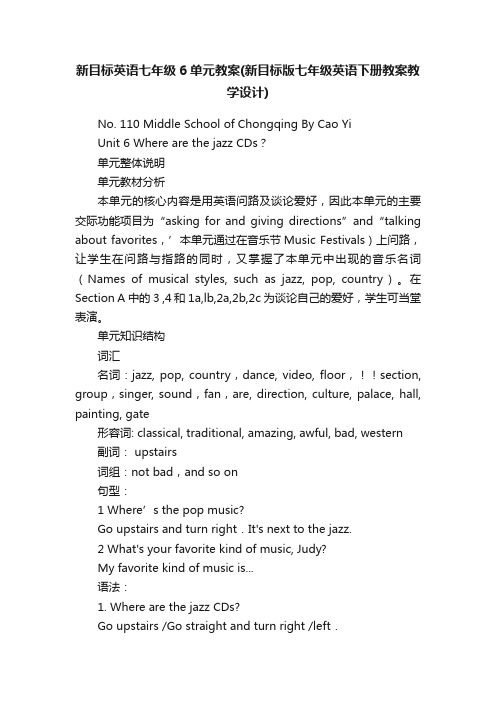
新目标英语七年级6单元教案(新目标版七年级英语下册教案教学设计)No. 110 Middle School of Chongqing By Cao YiUnit 6 Where are the jazz CDs?单元整体说明单元教材分析本单元的核心内容是用英语问路及谈论爱好,因此本单元的主要交际功能项目为“asking for and giving directions”and“talking about favorites,’本单元通过在音乐节Music Festivals)上问路,让学生在问路与指路的同时,又掌握了本单元中出现的音乐名词(Names of musical styles, such as jazz, pop, country)。
在Section A中的3 ,4和1a,lb,2a,2b,2c为谈论自己的爱好,学生可当堂表演。
单元知识结构词汇名词:jazz, pop, country,dance, video, floor,!!section, group,singer, sound,fan,are, direction, culture, palace, hall, painting, gate形容词: classical, traditional, amazing, awful, bad, western副词: upstairs词组:not bad,and so on句型:1 Where’s the pop music?Go upstairs and turn right.It's next to the jazz.2 What's your favorite kind of music, Judy?My favorite kind of music is...语法:1. Where are the jazz CDs?Go upstairs /Go straight and turn right /left.They are between the pop and the country2 The use of the sentences structures.单元整体目标1.Master the vocabulary.2.Master and use:Where are the country CDs?Go upstairs /Go straight and turn right /left.They are between …and …/next to… behind …单元教学重难点一览重点难点I The vocabulary.2 The Grammar. 1 Asking for and giving directions.2 Talking about favorite.单元学情分析本单元与前几个单元的学习自然衔接,继续学习询问和指点方向,而且与学生愿意接触的“音乐“有关,很大程度上能调动学生的学习积极性。
新目标英语初一英语词汇表总汇及精萃
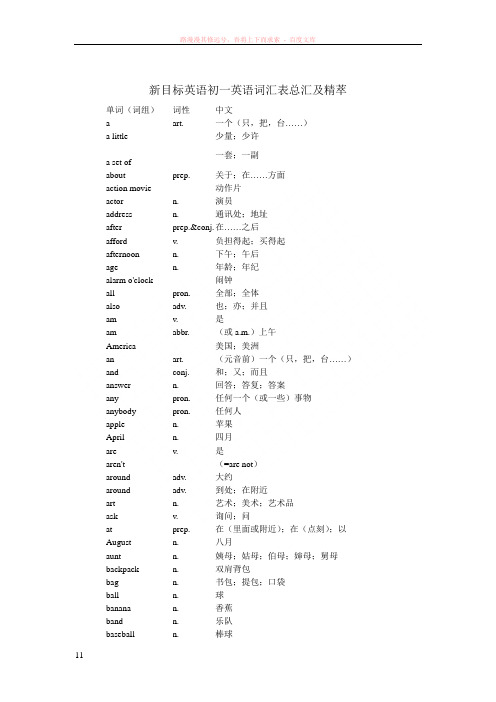
新目标英语初一英语词汇表总汇及精萃单词(词组)词性中文a art. 一个(只,把,台……)a little 少量;少许一套;一副a set ofabout prep. 关于;在……方面action movie 动作片actor n. 演员address n. 通讯处;地址after prep.&conj. 在……之后afford v. 负担得起;买得起afternoon n. 下午;午后age n. 年龄;年纪alarm o'clock 闹钟all pron. 全部;全体also adv. 也;亦;并且am v. 是am abbr. (或a.m.)上午America 美国;美洲an art. (元音前)一个(只,把,台……)and conj. 和;又;而且answer n. 回答;答复;答案any pron. 任何一个(或一些)事物anybody pron. 任何人apple n. 苹果April n. 四月are v. 是aren't (=are not)around adv. 大约around adv. 到处;在附近art n. 艺术;美术;艺术品ask v. 询问;问at prep. 在(里面或附近);在(点刻);以August n. 八月aunt n. 姨母;姑母;伯母;婶母;舅母backpack n. 双肩背包bag n. 书包;提包;口袋ball n. 球banana n. 香蕉band n. 乐队baseball n. 棒球basketball n. 篮球basketball game 篮球赛bat n. (网球、乒乓球等的)球拍be v. 是(表示存在、状态等)because conj. 因为bed n. 床before prep. 在……以前Beijing Opera 京剧best adj.&adv. (good, well的最高极)最好的(地)big adj.&adv. 大的;广大的;重大的biology n. 生物学birth n. 出生;出世;诞生birthday n. 生日black adj.&n. 黑色(的)blank n. 空白blue adj.&n. 蓝色(的)book n. 书bookcase n. 书橱;书箱boring adj. 无聊的;令人生厌的boy n. 男孩breakfast n. 早餐bring v. 拿来;取来;带来broccoli n. 花耶菜brother n. 兄;弟brush v. 刷bus n. 公共汽车busy adj. 忙的;繁忙的;忙碌的but conj. 但是buy v. 购买;买call v. 打电话can modal v. 能;可以;会can't (=can not)card n. 卡;卡片;纸牌carrot n. 胡萝卜case n. 箱;盒;橱CD abbr. (=compact disc)激光唱片chair n. 椅子chess n. 国际象棋chicken n. 鸡;鸡肉China 中国Chinese n. 中文;中国人Chinese adj. 中国的;中国人的city n. 城市class n. 班级;(一节)课clerk n. (银行、办公室、商店等)职员;办事员clock n. 时钟clothes n. (pl.)衣服;服装club n. 社团;俱乐部collection n. 收藏品;收集物color n. 色;颜色come v. 来;来到comedy n. 喜剧computer n. 电脑;电子计算机computer game 电子游戏contest n. 竞争;竞赛;比赛conversation n. 交谈;谈话countable noun 可数名词cousin n. 堂(表)兄弟;堂(表)姐妹cream n. 奶油;乳脂dad n. (非正式用语)爸爸dance v. 跳舞;舞蹈date n. 日期daughter n. 女儿day n. 天;日间;白天;一日dear adj. (冠于信函中的称谓以示礼貌)亲爱的December n. 十二月description n. 描述;记叙desk n. 书桌;课桌dessert n. (饭后的)甜食dictionary n. 字典;词典difficult adj. 困难的dinner n. 正餐;晚餐do v.&aux. (构成否定句、疑问句的助动词无意义)做;干;行动do homework 做作业documentary n. 纪录片does v.&aux. (动词do的第三人称单数)(构成否定句、疑问句的助动词无意义)做;干;行动doesn't (=does not)dog n. 狗dollar n. 元(美国、加拿大等国的货币单元,符号为$)don't (=do not)draw v. 画drawer n. 抽屉dresser n. 梳妆台;碗柜drum n. 鼓each pron. 每个eat v. 吃egg n. 蛋;鸡蛋eight num. 八eighteen num. 十八eighteenth num. 第十八eighth num. 第八eleven num. 十一eleventh num. 第十一e-mail n. (或email)电子邮件English n. 英语;英文eraser n. 橡皮;铅笔擦;黑板擦evening n. 傍晚;黄昏;晚上every adj. 每一;每个example n. 例子;实例exciting adj. 令人激动的;振奋人心的excuse v. 原谅;宽恕excuse me 请原谅(客套语,用于与陌生人搭话,打断别人说话等场合)family n. 家;家庭family name 姓氏father n. 爸爸;父亲favorite adj.&n. 最喜爱的(东西)February n. 二月festival n. (音乐,芭蕾舞,戏剧等之)节;节日fifteen num. 十五fifteenth num. 第十五fifth num. 第五find v. 寻找;查找first num. 第一first name 名字five num. 五floor n. 地板;地面food n. 食物for prep. (表示目的或原因)为了found adj. (find的过去式、过去分词)找回的four num. 四fourteen num. 第十四fourth num. 第四French fries (=French fried potatoes)炸马铃薯;薯条Friday n. 星期五friend n. 朋友from prep. 从;从……起fruit n. 水果fun adj. (口)有趣的;令人愉快的funny adj. 有趣的;好玩的furniture n. 家具(总称)game n. 运动;游戏get to 到达get up 起床girl n. 女孩go v. 去go home 回家go to a movie 去看电影go to bed 上床睡觉go to school 去上学go to work 去上班good adj. 良好的;令人满意的grandfather n. 祖父;外祖父grandmother n. 祖母;外祖母grandparent n. 祖父(母);外祖父(母)great adj. 美妙的;伟大的green adj.&n. 绿色(的)guitar n. 吉他hamburger n. 汉堡包happy adj. 愉快的;高兴的;满意的Happy Birthday! 生日快乐!has v. (have的第三人称单数形式)有;吃;饮hat n. 帽子have v. 有have v. 吃;饮have a look at 看一看;看一眼he pron. 他healthy adj. 健康的;强健的hello int. (表示问候)喂help v.&n. 帮助;援助her pron. 她的here adv. 这里;在这里Here you are. 给你。
新目标英语七年级上册 (2)
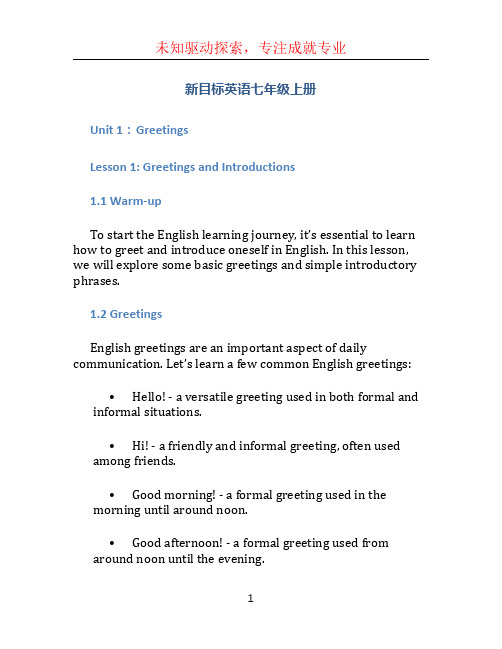
新目标英语七年级上册Unit 1:GreetingsLesson 1: Greetings and Introductions1.1 Warm-upTo start the English learning journey, it’s essential to learn how to greet and introduce oneself in English. In this lesson, we will explore some basic greetings and simple introductory phrases.1.2 GreetingsEnglish greetings are an important aspect of daily communication. Let’s learn a few common English greetings:•Hello! - a versatile greeting used in both formal and informal situations.•Hi! - a friendly and informal greeting, often used among friends.•Good morning! - a formal greeting used in the morning until around noon.•Good afternoon! - a formal greeting used from around noon until the evening.•Good evening! - a formal greeting used in the evening and at night.1.3 IntroductionsNext, let’s learn how to introduce ourselves in English. Here’s an example of a basic self-introduction:•A: Hello! My name is Alice. What’s your name?•B: Hi Alice! Nice to meet you. I’m Bob.In English, when introducing oneself, it is essential to include your name and greet the other person. It’s also customary to respond by offering a pleasant response when someone introduces themselves to you.1.4 PracticeTo reinforce the learning, let’s practice greetings and introductions. Role-play different scenarios with your classmates or use the following questions as prompts:•What’s your name?•How old are you?•Where are you from?Remember to use appropriate greetings and polite language during these interactions.1.5 Speaking ChallengeFor the speaking challenge, choose a partner and practice exchanging introductions. Make sure to greet each other and ask questions using the phrases you have learned.Lesson 2: Classroom English2.1 Warm-upIn this lesson, we will learn essential classroom English phrases that will help you communicate effectively with your teachers and peers.2.2 Classroom InstructionsTo ensure smooth classroom activities, teachers often use specific instructions in English. Let’s familiarize ourselves with some common classroom instructions:•Please sit down.•Raise your hand.•Stand up.•Open your book.•Close your book.•Pay attention.•Take out your pen/pencil.•Put away your belongings.2.3 Expressing NeedsWhen you need something in the classroom, it’s important to know how to express your needs. Here are some useful phrases:•Can I borrow a pen, please?•May I go to the restroom?•I need a piece of paper.•Can you help me, please?•I don’t understand.2.4 PracticeTo practice classroom English, engage in role-playing activities with your classmates. Act out different classroom scenarios and use the classroom instructions and phrases you have learned.2.5 Speaking ChallengeFor the speaking challenge, pair up with a classmate and take turns giving instructions or expressing needs. Practice using the phrases from this lesson and respond accordingly.Unit 2: My School LifeLesson 3: Daily Routines3.1 Warm-upIn this lesson, you will learn how to talk about your daily routines in English. Daily routines refer to the regular activities you engage in every day, such as waking up, eating breakfast, going to school, etc.3.2 Talking about Daily RoutinesTo talk about daily routines, we use time expressions and action verbs. Here are some examples:•I wake up at 7 am.•I brush my teeth.•I have breakfast at 7:30 am.•I go to school at 8 am.3.3 Adverbs of FrequencyWhen discussing daily routines, we often mention how frequently we perform certain actions. Adverbs of frequency help us express this. Here are some common adverbs of frequency:•Always•Usually•Often•Sometimes•Rarely•Never3.4 PracticeTo practice talking about daily routines, create a schedule for an average school day. Include the time and actions you typically perform. Share your schedule with a partner and discuss similarities and differences.3.5 Speaking ChallengeFor the speaking challenge, create a dialogue with a classmate where you discuss your daily routines. Incorporate the adverbs of frequency and time expressions into your conversation.Unit 3: My FamilyLesson 4: My Family4.1 Warm-upIn this lesson, we will learn vocabulary related to family members and how to describe them in English.4.2 Family VocabularyLet’s start by learning some common family member vocabulary:•Mother•Father•Sister•Brother•Grandmother•Grandfather•Aunt•Uncle•Cousin4.3 Describing Family MembersOnce you have learned the family member vocabulary, practice describing your family members using simple sentences. For example:•My mother is kind and caring.•My sister is funny and creative.•My grandfather likes to tell stories.4.4 PracticeTo reinforce your understanding and vocabulary, create a family tree. Include the names of your family members and describe their characteristics using adjectives.4.5 Speaking ChallengeFor the speaking challenge, create a presentation about your family. Introduce each family member and describe their personality traits. Use the vocabulary and sentence structures you have learned in this lesson.ConclusionIn this document, we have covered the first three units of the New Target English Grade 7 textbook. These units focused on greetings, classroom English, daily routines, and family vocabulary. By practicing these essential topics, you will be equipped with basic English communication skills that will serve as a foundation for further learning. Keep practicing and exploring the English language!。
人教版新目标初一(七年级)上册英语单词表带音标英式和美式音标

人教版新目标第一单元英语单词及短语1.my英音:[mai]美音:[maɪ]我的pron.2. name 英音:[neim]美音:[nem] 名字n.3. is英音:[iz]美音:[ɪz]是v.4. clock英音:[klɔk]美音:[klɑk]时钟n.5. I [ai] 我pron.6. am英音:[æm]美音:[æm]是v.7. I'm =I am8. nice英音:[nais]美音:[naɪs]好的;令人愉快的adj.9. to英音:[tu:]美音:[tu]用于与动词原形一起构成动词不定式 prep.10. meet英音:[mi:t]美音:[mit]遇见;相逢v.11. you英音:[ju:]美音:[ju]你;你们pron.12. what英音:[hwɔt]美音:[hwɑt]什么 pron.& adj.13. what's =what is 什么是14. your英音:[juə]美音:[juɚ]你的;你们的pron.15. hello英音:[hə'ləu]美音:[hə'lo](表示问候)喂int.16. hi英音:[hai]美音:[haɪ](表示问候)嗨int.17. his英音:[hiz]美音:[hɪz]他的pron.18. and英音:[ænd]美音:[ænd]和;又;而且conj.19. her英音:[hə:]美音:[hɝ] 她的pron.20. question英音:['kwestʃən]美音:['kwɛstʃən]问题;难题;询问;疑问n.21. answer英音:['ɑ:nsə]美音:['ænsɚ]问答;答复;答案n.22. look英音:[luk]美音:[luk]看;望;看起来v.23. first英音:[fə:st]美音:[fɝst]第一num.24. first name 名字25. last英音:[lɑ:st]美音:[læst]最后的;上一个的adj.26. last name 姓氏27. boy英音:[bɔi]美音:[bɔɪ]男孩n.28. girl英音:[gə:l]美音:[gɝl]女孩n.29. zero英音:['ziərəu]美音:['zɪro]零num.30. one英音:[wʌn]美音:[wʌn]一num.31. two英音:[tu:]美音:[tu]二num.32. three英音:[θri:]美音:[θri]三num.33. four英音:[fɔ:]美音:[for]四num.34. five英音:[faiv]美音:[faɪv]五num.35. six英音:[siks]美音:[sɪks]六num.36. seven英音:['sevn]美音:['sɛvn]七num.37. eight英音:[eit]美音:[et]八num.38. nine英音:[nain]美音:[naɪn]九num.39. telephone英音:['telifəun]美音:['tɛlə,fon]电话n.40. number英音:['nʌmbə]美音:['nʌmbɚ]数;数字n.41. telephone number 电话号码42. phone英音:[fəun]美音:[fon]电话;电话机n.43. phone number 电话号码44. it英音:[it]美音:[ɪt]它pron.45 it's=it is它是46. card英音:[kɑ:d]美音:[kɑrd]卡;卡片n47. ID card (ID=identification) 身份证identification英音:[ai,dentifi'keiʃən]美音:[aɪ,dɛntəfə'keʃən]48. family英音:['fæmili]美音:['fæməlɪ]家;家庭n.49. family name 姓氏新目标第二单元单词及短语1. this英音:[ðis]美音:[ðɪs]这;这个pron.& adj.2. pencil英音:['pensl]美音:['pɛns!]铅笔n.3. pen英音:[pen]美音:[pɛn]钢笔n.4. book英音:[buk]美音:[buk]书n.5. eraser英音:[i'reisə]美音:[ɪ'resɚ]橡皮;铅笔擦;黑板擦n.6. ruler英音:['ru:lə]美音:['rulɚ]尺;直尺n.7. case英音:[keis]美音:[kes]箱;盒;橱n.8. pencil case 铅笔盒;文具盒9. backpack英音:['bækpæk]美音:['bæk,pæk]双肩背包n.back英音:[bæk]美音:[bæk]背,背部pack英音:[pæk]美音:[pæk]包;捆;包裹;背包sharpener英音:['ʃɑ:pənə]美音:['ʃɑrpnɚ]磨具10. pencil sharpener 卷笔刀;铅笔刀11. dictionary英音:['dikʃəneri]美音:['dɪkʃən,ɛrɪ] 字典;词典n.12. that英音:[ðæt]美音:[ðæt] 那;那个pron.& adj.13. yes英音:[jes]美音:[jɛs] (表示肯定)是adv.14. no英音:[nəu]美音:[no] (表示否定)不;不是adv.15. not英音:[nɔt]美音:[nɑt] (构成否定形式)不是adv.16. isn't =is not17. thank英音:[θæŋk]美音:[θæŋk] 感谢v.18. OK 好;不错 interj19. in英音:[in]美音:[ɪn] 用(表示方法,媒介,工具等)prep.20. English英音:['iŋgliʃ]美音:['ɪŋglɪʃ] 英语;英文n.21. a英音:[ei]美音:[ə] 一个(只,把,台……)art.22. how英音:[hau]美音:[hau] (指程度)多么;何等;怎样adv.23. do英音:[du:]美音:[du] 做;干;构成否定句、疑问句的助动词v.& aux.24. spell英音:[spel]美音:[spɛl] 拼写v.base英音:[beis]美音:[bes] 基础;基料ball英音:[bɔ:l]美音:[bɔl] 球;球状体25. baseball英音:['beis,bɔ:l]美音:['bes,bɔl] 棒球n.26. watch英音:[wɔtʃ]美音:[wɑtʃ] 手表n.27. computer英音:[kəm'pju:tə]美音:[kəm'pjutɚ] 电脑n.28. game英音:[geim]美音:[gem] 运动;游戏n.29. key英音:[ki:]美音:[ki] 钥匙n.30. notebook英音:['nəutbuk]美音:['not,buk] 笔记本n.31. ring英音:[riŋ]美音:[rɪŋ] 环(状物);戒指n.32. call英音:[kɔ:l]美音:[kɔl] 打电话 v.33. at英音:[æt]美音:[æt] 在…(里面或附近);在…(点、刻);以 prep.34. the英音:[ðə]美音:[ðə] 表示特指的人、物、事或群体art.35. lost英音:[lɔst]美音:[lɔst] 丢失的;遗失的adj.36. found英音:[faund]美音:[faund] (find的过去式,过去分词)找回 v.37. lost and found 失物招领38. please英音:[pli:z]美音:[pliz] (祈使句用作请求的客套话)请interj39. school英音:[sku:l]美音:[skul] 学校 n.40. a set 英音:[set]美音:[sɛt] 一套;一副41. of 英音:[ɔv]美音:[ɑv] (属于)…的42. excuse英音:[iks'kju:z]美音:[ɪk'skjuz] 原谅;宽恕 v.43. excuse me 请原谅第三单元单词及短语1. sister英音:['sistə]美音:['sɪstɚ] 姐;妹n.2. mother英音:['mʌðə]美音:['mʌðɚ] 妈妈;母亲n.3. father英音:['fɑ:ðə]美音:['fɑðɚ] 爸爸;父亲 n.4. parent英音:['pɛərənt]美音:['pɛrənt] 父亲或母亲n.5. brother英音:['brʌðə]美音:['brʌðɚ] 兄;弟n.grand英音:[grænd]美音:[grænd]全部的,总的前缀 pref. 1.表示"祖父母辈的"(如:grandfather) 2.表示"孙子女辈的"(如:granddaughter6. grandmother英音:['grænd,mʌðə]美音:['grænd,mʌðɚ] 祖母;外祖母n.7. grandfather英音:['grænd,fɑ:ðə]美音:['grænd,fɑðɚ] 祖父;外祖父n.8. friend英音:[frend]美音:[frɛnd] 朋友n.9. grandparent英音:['grænd,pɛərənt]美音:['grænd,pɛrənt] 祖父/母;外祖父/母n.10. these英音:[ði:z]美音:[ðiz] 这些 pron.& adj.11. are英音:[ɑ:]美音:[ɑr] 是v.12. those英音:[ðəuz]美音:[ðoz] 那些pron.& adj.13. she英音:[ʃi:]美音:[ʃi] 她pron.14. he英音:[hi:]美音:[hi] 他pron.15. picture英音:['piktʃə]美音:['pɪktʃɚ] 照片;图片 n.16. son英音:[sʌn]美音:[sʌn] 儿子 n.17. cousin英音:['kʌzn]美音:['kʌzn] 堂(表)兄弟;堂(表)姐妹n.18. daughter英音:['dɔ:tə]美音:['dɔtɚ] 女儿 n.19. uncle英音:['ʌŋkl]美音:['ʌŋk!] 叔;伯;舅;姨夫;姑父 n.20. aunt英音:[ɑ:nt]美音:[ænt] 姨母;姑母;伯母;婶母 n.21. dear英音:[diə]美音:[dɪr] (冠于信函中的称谓,以示礼貌)亲爱的adj.25. for英音:[fɔ:]美音:[fɔr] 为了 prep 22. thanks for 为……而感谢23. photo英音:['fəutəu]美音:['foto] 照片;相片n.24. here英音:[hiə]美音:[hɪr] 这里;在这里adv.第四单元单词及短语1. where英音:[hwɛə]美音:[hwɛr]哪里 adv2. table英音:['teibl]美音:['teb!]桌子n.3. bed英音:[bed]美音:[bɛd]床 n.4. dresser英音:['dresə]美音:['drɛsɚ]梳妆台n.5. bookcase英音:['bukkeis]美音:['buk,kes]书柜;书橱n.6. sofa英音:['səufə]美音:['sofə]沙发n.7. chair英音:[tʃɛə]美音:[tʃɛr]椅子n.8. drawer英音:['drɔ:ə]美音:['drɔɚ]抽屉n.9. plant英音:[plɑ:nt]美音:[plænt]植物n.10. under英音:['ʌndə]美音:['ʌndɚ]在..下面 prep.11. they英音:[ðei]美音:[ðe]他们 pron.12. on英音:[ɔn]美音:[ɑn]在..上面 prep.13. know英音:[nəu]美音:[no]知道;了解 v.14. bag英音:[bæg]美音:[bæg]书包;提包;袋子 n.15. math英音:[mæθ]美音:[mæθ]数学 n.alarm英音:[ə'lɑ:m]美音:[ə'lɑrm]警报;警报器16. alarm clock 闹钟compact英音:[kəm'pækt]美音:[kəm'pækt]结实的;带镜粉盒disc英音:[disk]美音:[dɪsk]圆盘;盘状物;圆平面abbreviation英音:[ə,bri:vi'eiʃən]美音:[ə,brivɪ'eʃən]缩写,省略;缩短17. CD (=compact disc) 光盘 abbr.18. video英音:['vidiəu]美音:['vɪdɪ,o]录像;视频 n.19. tape英音:[teip]美音:[tep]录音带 n.20. video tape录像带21. hat英音:[hæt]美音:[hæt]帽子 n.22. take英音:[teik]美音:[tek]拿走;带到 v.23. thing 英音:[θiŋ]美音:[θɪŋ]东西;物 n.prep英音:[prep]美音:[prɛp]预习;预备班(或学校);准备工作24. to英音:[tu:]美音:[tu]朝;向;至;达 prep.25. mom英音:[mɔm]美音:[mɑm] (非正式用语)妈妈 n.modal英音:['məudl]美音:['modl]情态词;形态上的;形式的;程序的26.can英音:[kæn]美音:[kæn]能;可以;会 modal v.27. bring英音:[briŋ]美音:[brɪŋ]拿来;取来;带来 v.pron代词adj形容词28. some英音:[sʌm]美音:[sʌm]一些;若干pron.& adj.29. need英音:[ni:d]美音:[nid]需要 v.30. floor英音:[flɔ:]美音:[flor]地板;地面 n.31. room英音:[ru:m]美音:[rum]房间 n.television英音:['teli,viʒən]美音:['tɛlə,vɪʒən]电视;电视机 (=television) 电视;电视机 abbr.33. desk英音:[desk]美音:[dɛsk]课桌;书桌 n.第五单元单词及短语1. have英音:[hæv]美音:[hæv]有;吃;饮v.2. soccer英音:['sɔkə]美音:['sɑkɚ]英式足球 n.3. ball英音:[bɔ:l]美音:[bɔl] 球 n.4. soccer ball 英式足球5. tennis英音:['tenis]美音:['tɛnɪs]网球 n.6. racket英音:['rækit]美音:['rækɪt](网球、羽毛球的)球拍 n.7. tennis racket 网球拍8. ping-pong英音:['piŋpɔŋ]美音:['pɪŋ,pɑŋ]乒乓球 n.volley英音:['vɔli]美音:['vɑlɪ]齐射出的子弹(或箭等)9.volleyball英音:['vɔli,bɔ:l]美音:['vɑlɪ,bɔl]排球 n.basket英音:['bɑ:skit]美音:['bæskɪt]篮,篓,筐10. basketball英音:['bæskitbɔ:l]美音:['bæskɪt,bɔl]篮球 n.11. bat英音:[bæt]美音:[bæt](乒乓球等的)球拍 n.auxiliary英音:[ɔ:g'ziljəri]美音:[ɔg'zɪljərɪ]助动词;辅助的;补充的12. does英音:[dʌz]美音:[dʌz] (do的第三人称单数)做;干;构成否定句、疑问句的助动词 v.& aux.13. doesn't = dost not14. let英音:[let]美音:[lɛt]允许;让 v.15. us英音:[ʌs]美音:[ʌs]我们(we的宾格)pron.16. let's =let us让我们17. play英音:[plei]美音:[ple]玩;打球 v.18. sound英音:[saund]美音:[saund]听起来v.19. good英音:[gud]美音:[gud]良好的;令人满意的adj.20. sport英音:[spɔ:t]美音:[sport]运动;游戏 n.21. we英音:[wi:]美音:[wi]我们pron.22. many英音:['meni]美音:['mɛnɪ]大量的adj.23. club英音:[klʌb]美音:[klʌb]社团;俱乐部 n.24. more英音:[mɔ:]美音:[mor]更多的;更大的 pron.25. class英音:[klɑ:s]美音:[klæs](一节)课;班级 n.interest英音:['intərist]美音:['ɪntərɪst]兴趣;关注;爱好sting英音:[stiŋ]美音:[stɪŋ]刺痛,使疼痛26. interesting英音:['intəristiŋ]美音:['ɪntərɪstɪŋ]有趣的;令人感兴趣的adj.27. boring英音:['bɔ:riŋ]美音:['borɪŋ]无聊的;令人生厌的adj.28. fun英音:[fʌn]美音:[fʌn]有趣的;令人愉快的adj.29. difficult英音:['difikəlt]美音:['dɪfə,kəlt]困难的adj.30. relaxing英音:[ri'læksiŋ]美音:[rɪ'læksɪŋ]轻松的adj.31. watch英音:[wɔtʃ]美音:[wɑtʃ]观看;注视 v.32. watch TV 看电视33. has英音:[hæz]美音:[hæz](have的第三人称单数形式)有v.34. great英音:[greit]美音:[gret]美妙的;大的adj.35. collection英音:[kə'lekʃən]美音:[kə'lɛkʃən]收藏品;收集物 n.36. but英音:[bʌt]美音:[bʌt]但是conj.sports英音:[spɔ:ts]美音:[spɔrts]运动的;(指衣服等)适用于运动的37. play sports 参加体育运动或比赛conj连接词 adv副词38. only英音:['əunli]美音:['onlɪ]只;仅仅adv.39. them英音:[ðem]美音:[ðɛm] (they的宾格)他(她、它)们pron.they英音:[ðei]美音:[ðe] (主格)他们;她们;它们40. every英音:['evri]美音:['ɛvrɪ]每一;每个adj.41. day英音:[dei]美音:[de]天;日间;白天;一日n.第六单元单词及短语1. like英音:[laik]美音:[laɪk]喜欢 v.2. banana英音:[bə'nɑ:nə]美音:[bə'nænə]香蕉 n.3. hamburger英音:['hæmbə:gə]美音:['hæmbɝgɚ]汉堡包n.4. tomato英音:[tə'meitəu]美音:[tə'meto]西红柿n.5. broccoli英音:['brɔkəli]美音:['brɑkəlɪ]花椰菜n.French英音:[frentʃ]美音:[frɛntʃ]n. 法国人;法语 a. 法国的;法语的fries英音:[fraiz]美音:[fraɪz]炸薯条6. French fries 炸马铃薯条;薯条7. orange英音:['ɔ:rindʒ]美音:['ɔrɪndʒ]橙子n.8. ice英音:[ais]美音:[aɪs]冰n.9. cream英音:[kri:m]美音:[krim]奶油;乳脂n.10. ice cream 冰淇淋11. salad英音:['sæləd]美音:['sæləd]沙拉n.straw英音:[strɔ:]美音:[strɔ]稻草,麦秆berry英音:['beri]美音:['bɛrɪ](葡萄,番茄等)浆果;干果仁;干种子12. strawberry英音:['strɔ:bəri]美音:['strɔbɛrɪ]草莓n.ear英音:[iə]美音:[ɪr]耳朵13. pear英音:[pɛə]美音:[pɛr]梨n.14. have英音:[hæv]美音:[hæv]吃;饮v.15. oh英音:[əu]美音:[o]啊;噢;呀(表示惊讶等)interj.interj. 感叹词table英音:['teibl]美音:['teb!]桌子;餐桌;台countable英音:['kauntəbl]美音:['kauntəb!]可计算的;可数的noun 英音:[naun]美音:[naun]n.【语】名词16. countable noun 可数名词uncountable英音:['ʌn'kauntəbl]美音:[ʌn'kauntəb!]a. 无数的;不可数的17. uncountable noun 不可数名词18. food英音:[fu:d]美音:[fud]食物n.19. egg英音:[eg]美音:[ɛg]蛋;鸡蛋n.20. apple英音:['æpl]美音:['æpl]苹果n.21. carrot英音:['kærət]美音:['kærət]胡萝卜n.22. chicken英音:['tʃikin]美音:['tʃɪkɪn]鸡;鸡肉n.break英音:[breik]美音:[brek]毁坏,弄坏;砸破fast英音:[fɑ:st]美音:[fæst]快的;迅速的;速度快的23. breakfast英音:['brekfəst]美音:['brɛkfəst]早餐n.24. lunch英音:[lʌntʃ]美音:[lʌntʃ]午餐n.25. dinner英音:['dinə]美音:['dɪnɚ]晚餐;正餐n.26. fruit英音:[fru:t]美音:[frut]水果n.27. vegetable英音:['vedʒitəbl]美音:['vɛdʒətəb!]蔬菜;植物n.28. runner英音:['rʌnə]美音:['rʌnɚ]奔跑者n.29. eat英音:[i:t]美音:[it]吃v.30. well英音:[wel]美音:[wɛl]好;对;满意地adv.31. run英音:[rʌn]美音:[rʌn]跑;奔跑v.32. star英音:[stɑ:]美音:[stɑr]星星;明星n.33. lot英音:[lɔt]美音:[lɑt]许多;很多adv.34. lots of 大量;许多heal英音:[hi:l]美音:[hil]治愈,愈合thy英音:[ðai]美音:[ðaɪ]【古】你的(thou的所有格);胸腺抗原thou英音:[ðau]美音:[ðau]【古】(第二人称单数主格)汝,尔,你35. healthy英音:['helθi]美音:['hɛlθɪ]健康的;强健的adj.36. dessert英音:[di'zə:t]美音:[dɪ'zɝt](饭后的)甜食n.37. list英音:[list]美音:[lɪst]清单n.38. Bill英音:[bil]美音:[bɪl]比尔(男名)39. Sandra 桑德拉(女名)40. Clark英音:[klɑ:k]美音:[klɑrk]克拉克(姓)review英音:[ri'vju:]美音:[rɪ'vju]复习功课,温习功课unit英音:['ju:nit]美音:['junɪt]单位;单元Review of units 1---61. furniture英音:['fə:nitʃə]美音:['fɝnɪtʃɚ]家具(总称)n.2. people英音:['pi:pl]美音:['pip!]人;人民n.3. an英音:[æn]美音:[æn](元音前)一个(只,把,台…)art.art英音:[ɑ:t]美音:[ɑrt]艺术;美术4. blank英音:[blæŋk]美音:[blæŋk]空白n.5. conversation英音:[,kɔnvə'seiʃən]美音:[,kɑnvɚ'seʃən]交谈;谈话n.6. other英音:['ʌðə]美音:['ʌðɚ]另外的人(物)pron.7. also英音:['ɔ:lsəu]美音:['ɔlso]也;亦;而且adv.adv. 副词8. Joe英音:[dʒəu]美音:[dʒo]乔(男名)第七单元单词及短语how英音:[hau]美音:[hau](指数量、程度)多少much英音:[mʌtʃ]美音:[mʌtʃ]许多,大量1. how much (价钱)多少2. pants英音:[pænts]美音:[pænts]裤子3. sock英音:[sɔk]美音:[sɑk]短袜n.4. shirt英音:[ʃə:t]美音:[ʃɝt]男衬衣;衬衫n.5. T-shirt T恤衫n.6. shorts英音:[ʃɔ:ts]美音:[ʃɔrts]短裤n.7. sweater英音:['swetə]美音:['swɛtɚ]毛衣n.8. shoe英音:[ʃu:]美音:[ʃu]鞋n.9. skirt英音:[skə:t]美音:[skɝt]裙子n.10. sale英音:[seil]美音:[sel]出售;廉价销售n.11. dollar英音:['dɔlə]美音:['dɑlɚ]元(美国、加拿大等国的货币单位,符号为$)12. color英音:['kʌlə]美音:['kʌlɚ]色;颜色n.13. black英音:[blæk]美音:[blæk]黑色(的)adj.& n.14. white英音:[hwait]美音:[hwaɪt]白色(的)adj.& n.15. red英音:[red]美音:[rɛd] 红色(的)adj.& n.16. green英音:[gri:n]美音:[grin] 绿色(的)adj.& n.17. blue英音:[blu:]美音:[blu]蓝色(的)adj.& n.18. yellow英音:['jeləu]美音:['jɛlo]黄色(的)adj.& n.19. big英音:[big]美音:[bɪg]大的;广大的;重大的adj.20. small英音:[smɔ:l]美音:[smɔl]小的;小号的adj.21. short英音:[ʃɔ:t]美音:[ʃɔrt]短的;矮的adj.22. long英音:[lɔŋ]美音:[lɔŋ]长的adj.23. clerk英音:[klɑ:k]美音:[klɝk](银行、办公室、商店等)职员;办事员n.24. help英音:[help]美音:[hɛlp]帮助;援助v.25. want英音:[wɔnt]美音:[wɑnt]需要;想要v.here英音:[hiə]美音:[hɪr]这里,在这里;向这里26. Here you are. 给你27. welcome英音:['welkəm]美音:['wɛlkəm]不必客气的adj.28. You’re welcome. 不客气。
预习 初一英语上册新目标七年级英语各单元语法梳理

预习初一英语上册新目标七年级英语各单元语法梳理
1. Her clock is on the desk. 她的闹钟在书桌上。
2. My baseball is under the bed. 我的棒球在床下。
3. His keys are in his schoolbag. 他的钥匙在他的书包里。
【妙语诠释】
对上面这些例句中的划线部分提问,需要用特殊疑问词where,其句型结构为:Where be ...? 意为“……在哪里?”。
用来对位置提问,该句型中 be 的单复数要与其后主语的单复数保持一致。
例如:
-Where is her clock? 她的闹钟在哪里?
-Her clock is on the desk.
-Where is your baseball? 你的棒球在哪里?
-My baseball is under the bed.
-Where are his keys? 他的钥匙在哪里?
-His keys are in his schoolbag.。
人教新目标七年级英语上册电子课本(版)

⼈教新⽬标七年级英语上册电⼦课本(版)Language Goals: Introduce yourself ;Greet people ; Ask for and give telephone numberA: Nice to meet you!1c Practice the conversations above with your partner. Then greet your classmates. 练习上⾯的对话,然后问候你的同学。
2a Listen to the conversations and number the pictures [1 — 4]. 听对话,为图⽚编号。
Unit 1 Myname s G.i na语⾔⽬标:介绍⾃⼰;问候他⼈;询问和告知电话号码1aWrite English words for the things in the picture. 写出图中物品的英⽂名称。
1b Listen and number the conversations [ 1-3].听录为对话编号。
□ A: What ' s your name? □A:Good morning! □A:Hi. My name ' s Gina. B:Alan.I ' m Jenny. Nice to meet you!A: Hello, Alan. I ' m Ms Bro B: Hello, Cindy. I ' mD ale.2b Listen again. Circle the names you hear. 再听⼀遍录⾳,圈出你听到的名字。
Eric Tom Alice Bob Mike Jack Mary Ms. Miller 2c Practice the conversations in pairs.两⼈⼀组练习下⾯的对话。
A: Hello! What' s your name A: What' s his name?B: My name' s?B: His name is ?A: I 'm?A: And what 's hear mne?B: Nice to meet you! B: Her name is 2d Role play the conversation. 分⾓⾊表演对话Linda: Good afternoon! My name 's Linda.Are you Helen?Helen: Yes, I am. Nice to meet you,Linda. Linda: Nice to meet you, too.What' s her name?Helen: She's Jane. Linda: Is he Jack?Helen: No, he isn 'Hits. name 's Mike.What' s your anme? Alan. /I 'm Alan./My name 's AlanWhat' s his name? He's Eric./ His name 's Eric.3a Put the words in order to make conversations. Then practice them.组成对话并练习。
新目标(Go for it)版七年级英语下册各单元知识点总结
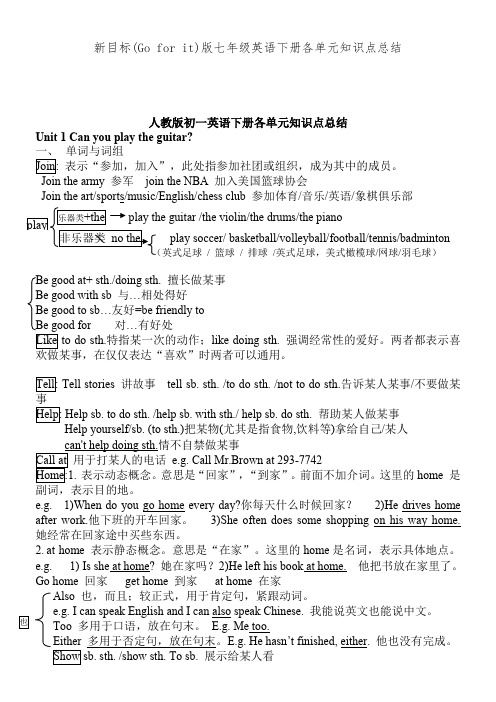
新目标(Go for it)版七年级英语下册各单元知识点总结人教版初一英语下册各单元知识点总结Unit 1 Can you play the guitar?一、 单词与词组表示“参加,加入”,此处指参加社团或组织,成为其中的成员。
Join the army 参军 join the NBA 加入美国篮球协会Join the art/sports/music/English/chess club 参加体育/音乐/英语/象棋俱乐部play soccer/ basketball/volleyball/football/tennis/badminton / 篮球 / 排球 /英式足球,美式橄榄球/网球/羽毛球)Be good at+ sth./doing sth. 擅长做某事Be good with sb 与…相处得好Be good to sb …友好=be friendly toBe good for 对…有好处特指某一次的动作;like doing sth. 强调经常性的爱好。
两者都表示喜讲故事 tell sb. sth. /to do sth. /not to do sth.告诉某人某事/不要做某帮助某人做某事Help yourself/sb. (to sth.)把某物(尤其是指食物,饮料等)拿给自己/某人e.g. Call Mr.Brown at 293-7742意思是“回家”,“到家”。
前面不加介词。
这里的home 是e.g. 1)When do you go home every day?你每天什么时候回家? 2)He drives home after work.他下班的开车回家。
3)She often does some shopping on his way home. 她经常在回家途中买些东西。
2. at home 表示静态概念。
意思是“在家”。
这里的home 是名词,表示具体地点。
人教版新目标英语七年级上册 __Unit1_My_name’s_Gina_Section A 3
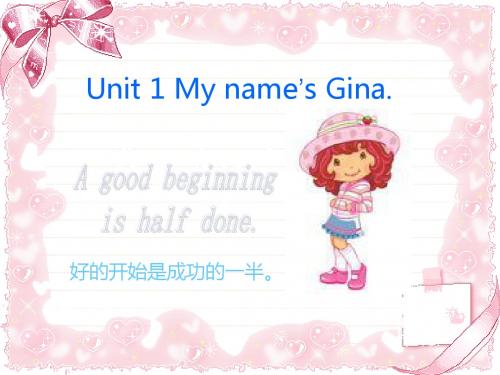
三、选词填空。
name’s, isn’t, yes, I’m, what’s, she, his, are 1. —Good morning! ______ I’m Dale. —Hello, Dale. My _______ name’s Jenny. Are you Mr. Green? 2. —_____ —____, Yes I am. 3. —________ What’s his name? —____ His name’s Tony. 4. —Is ____ she Ms. Brown? —No, she ______. isn’t She’s Ms. Miller.
Her name’s…/ She’s … /…
His name is Yao Ming .
Is he Jack? No, he isn’t.
Is he Yao Ming. Yes, he is.
She’s Li Wen.
Is she Alice? No, she isn’t.
Is she Li Wen? Yes, she is.
Gina
I’m Jenny. Nice to meet you!
Jenny
Nice to meet you, too.
询问姓名的问答 ---What’s your name ?
---My name’s Gina. = I’m Gina. = Gina.
What’s this in English? It’s a …. 1a
Unit 1 My name’s Gina.
好的开始是成功的一半。
name
[neɪm] 诶
nice [naɪs]
爱 too 也,有,太
meet [mi:t]
人教版新目标英语七年级上册全册课文翻译

人教版新目标英语七年级上册全册课文翻译 Document serial number【KK89K-LLS98YT-SS8CB-SSUT-SST108】预习单元1—3Starter Unit 11a 早上好,海伦!嗨,鲍勃!早上好,艾丽斯!早上好,辛迪!你好,弗兰克!你好,埃里克!早上好,戴尔!3a 下午好,埃里克!下午好,弗兰克!早上好,海伦!早上好,戴尔!晚上好,鲍勃!晚上好,艾丽斯!3c 下午好,戴尔!嗨,辛迪!你好吗?我很好,谢谢。
你好吗?我很好。
Starter Unit 21a 这用英语怎么说?它是一个橙子。
那用英语怎么说??它是一件夹克衫。
3c 这个用英语怎么说?它是一张地图。
请把它拼写一下。
M-A-P.3e那个用英语怎么说?它是一个橙子。
请把它拼写一下。
O-R-A-N-G-E.Starter Unit 31a 这是什么?它是字母V。
它是什么颜色的?它是红色的。
那是什么?它是字母Z。
它是什么颜色的?它是黑色的。
3d这用英语怎么说?它是一把钥匙。
请把它拼写一下。
K-E-Y。
它是什么颜色的?它是黄色的。
一单元Section A 1b你叫什么名字?艾伦。
你好,艾伦。
我是布朗女士。
早上好!我是辛迪。
你好,辛迪!我是戴尔。
见到你很高兴。
2d 下午好!我的名字是琳达。
你是海伦吗?是的,我是。
见到你很高兴,琳达。
见到你我也很高兴。
她的名字是什么?她是简。
他是杰克吗?不,他不是。
他的名字是迈克。
Section B 1c 你的电话号码是什么,李欣?它是281-6926。
2a你的名字是什么?杰克。
你的姓氏是什么?史密斯。
2b 1.我的名字是珍妮-格林,我的电话号码是281-9176。
我的朋友是吉娜-史密斯。
她的电话号码是232-4672.2.我是戴尔-米勒并且我的朋友是埃里克-布朗。
他的电话号码是357-5689.我的电话号码是358-6344.3.我的名字是玛丽布朗。
我的朋友是在中国。
她的名字是张明明。
新目标初一英语下知识总结及练习答案讲解

七年级英语提高训练一Unit 1 Can you play the guitar学校:年级:姓名:一.基础知识梳理A: Can you draw B: Yes, I can. I want to join the art club.C: Can you swim D: No, I can’t.E: Oh, can you sing F: Yes, I can. I want to join the music club. D.考点语法:情态动词can的使用1.表示能力,表“会”“能”,指脑力或体力方面的“能力”--- I can play basketball well.2.表示许可----You can’t play here.3.表“请求”--- Can you help me二.基础知识运用1.根据首字母和句意提示完成单词;1. He likes playing basketball. So he wants to join_______ the basketball club.2. ---Can you speak_____ English ---Yes, I can.3. I can paint. I want to join the art club.4. I can play the guitar and the volin. I can sing and dance, talk.5. Do you have time on the weekend .6. If you are a good musician, you can be in the music festival festival.7. What can you do in the school show8. Which do you like, English or Chinese2.单项选择B 1. ----Can you ----Yes. I am in the art club now.A. swimB. paintC. danceD. singD 2. ----Can you play the guitar ----Yes. But I can’t play it very.A. badB. badlyC. goodD. Wellvery good相当于very nice. 意思是非常好,用来修饰名词.例子:The book is very good/nice.这本书非常好.very well 意思也是非常好,但它有两个用途:1.表示人的身体很好,属于形容词性短语,仅限于表示人的身体好,假如你跟一个人偶遇,他就想问问你认识的某人身体咋样,那你就可以回答说谁谁谁very well.例子:My mother is very well.我妈妈身体很好.2.还可以用来表示很好地,这时候它就相当于一个副词,可以用来修饰动词和形容词.例子:He study English very well.他的英语学得非常好.A 3. ---- ----Chess club.A. What club do you want to joinB. Can you play the chessC. What can you doD. Do you join the chess clubB 4. ----Do you know Lang Lang ---Yes. He is a . He can play the piano very well.A. playerB. musicianC. teacherD. singerC 5. ----How is your school trip ----Great. I can you the photos.A. makeB. findC. showD. buyD 6. ----Can you me with my English ---OK.A. learnB. speakC. teachD. Help help with 帮助B 7. ----Can your friend, Tony, the trumpet 喇叭;小号----Yes. He likes it very much.A. play; playsB. play; playingC. plays; playsD. plays; playingyour friend和Tony之间是同位关系,实际上该句子相当于:Can your friend play the trumpet 当表示喜欢某事物,而且以前就喜欢,还可能持续,用Like doing sth当表示想要,欲做某事用like to doB 8. ---What does he like doing after school ---Playing .A. gameB. chessC. the tennisD. Swimminggamesc 9. ----Can I help you --- I want to buy a book.A. No, thanksB. Thanks a lot 十分感谢C. Yes, please.D. You’re welcome 不客气thank you 或者Thanks a lot用这个回答A 10. Can he EnglishlA. speakB. talkC. sayspeak 意为“说话、讲话”,后面主要接语言.如:He can speak English and a little Chinese.talk 意为“谈话、讲话”,如果只有一方对另一方说话时,一般用talk to;如果双方或多方交谈,多用with. say 意为“说”通常跟讲者所说的话一起使用Please say hello / thank you to your mum.B 11. My brothers want the chess club.A. to speakB. to joinC. joinswant to do想做某事,want意思是“想要”,主语常是人I want to go to schoolwant doing 需要做某事,want意思是“需要、要求”,主语常是物The house wants repairingC 12. ----Can you play the guitar ----A. No, I canB. Sure, I can’tC. Yes, a little.B 13. My sister can very well. So she wants to join the club.A. swims; swimmingB. swim; swimmingC. swimming; swimC 14. _______club do you want to joinA. WhenB. WhereC. WhatC 15. I don’t want to play _____violin. Let’s go and play ________ ping-pong.A. a; theB. the; aC. the; /接球类和棋类时不加冠词,如:play football, play ping-pong,play chess;接乐器时加定冠词the,如play the violeen 中国的乐器前不加冠词;3. 交际技能及运用C D A F B EB.Mrs. Black: What can I do for you, young manDavid: I like sports. I want to Join your Sports Club .Mrs. Black: OK. What’s your full name, pleaseDavid: David Cooper.Mrs. Black: HOW OLD ARE YOUDavid: 14.Mrs. Black: What’s your favorite sport Can you play tennisDavid: Yes, I can.Mrs. Black: Do you like playing basketballDavid: Yes, but I CAN’T play it very well.Mrs. Black: Why do you want to join the club, may I askDavid: Because I really want to keep healthy and meet/make friends .Mrs. Black: Oh, I see. Can I have your phone number and email addressMrs. Black: OK. Welcome to our sports club.You can come hereon Sunday .at, in , on, 和by 表示时间的区别:at指时间表示:1时间的一点,一时刻:They come home at surprise at noon, at midnight, at ten o’clock, at daybreak, at dawn.2 较短的一段时间;可指某个节日或认为一年中标志大事的日子;His grandfather died at seventy-two.At the beginning middle, end of that month he was sick.He went home at Christmas at New Year, at the spring Festival, at night, at midsummer.In指时间表示:1在某个较长的时间如世纪,朝代,年,月,季节,及泛指的上午,下午和晚上等内;He died in the holidays.He was born in 1942.2 在一段时间之后;He will come round in a day or two.I will finish it in three hours.On指时间表示:1具体的时日和一个特定的时间,如某日,某节日,星期几等;He will come to meet us on our arrival.On May 4th On Sunday, On New Year’s day, On Christmas Day, there will be a celebration.2 在某个特定的早晨,下午或晚上;He arrived at 10 o’clock on the night of the 5th.He died on the eve of victory.3 准时,按时;If the rain should be on time, I should reach home before dark.In 表示比较大的地方,2虽然是很小的地方,如果说话人住在那里,也可用in.商店,机关,学校等,若看作一个地点point用at,若看作一个场所place用in.I met him at the post-office.I’m now working in the post-office.On表示地点,一般指与面或线接触:1“在…上面”He put the book on the table and sat on the chair.The picture was hanging on the wall.2 “在……旁边”New work is on the Hudson River.Xiamen is on the river.He lives in a house on the river.1. near, by, beside, at表示“在附近”的区别:near 表示相对的“近”,实际距离可能还很远;例如:There is a post office near our school.Suzhou is near Shanghai.By和beside都表示“靠近”,实际距离不可能很远,但beside比by更具体的表示出“在旁边”的意思;例如:There is a big tree by the river.He was sitting beside her.by还可以表示“尺寸,距离”;例如:They escaped death by inches.Do you see the hole high up in the wall, about 18 cm by 9三.能力提高训练Rick is a fat man. He gets up late晚in the morning . He has a big breakfast every morning. He has some meat, three or four eggs and some pieces of bread面包. He drinks two glasses of milk, some apple juice, a cup of coffee and some fruit. His wife, Vicky, has a cup of tea, a piece of bread and a banana for breakfast. Rick doesn’t like any ball games. He thinks they are too hard for him, but he likes listening to the music and watching TV and he doesn’t do any housework家务. Vicky plays sports every day. In fact, she is in a swimming club. So she is very healthy .1. K2. A3. D4. H5. B6. C7. I8. E9. G 10. J2. 阅读理解Do you like children Do you have free空闲的time in the afternoon We need a babysitter保姆for our son. He’s five years old. The working time is Monday to Friday, 3:00 pm to 6:pm. $ 5 an hourWe need help with: Looking after our son; Reading to him; Playing with him.You must work at our house. We live in Changchun, near the Culture Square文化广场. Please call Mr. Green at 5638—2949.根据短文内容选择正确答案1. From Monday to Friday, the babysitter can work ______ every day.A. one hourB. two hoursC. three hoursD. four hours2. Which is NOT the work that the babysitter needs to doA. Cooking for the child.B. Playing with the child.C. Reading books to the child.D. Looking after the child.3. The babysitter must work _______.A. at the babysitter’s houseB. at Miss Green’s school.C. at Mr. Green’s house.D. at the Culture Square4. The child in the ad is _______.A. 15 months oldB. 15 years oldC. 5 months oldD. 5 years old5. If ______, you can get the job.A. you like children, but you have no time in the afternoonB. you like children, but you d on’t know how to play with themC. you’re good with children and you’re free in the afternoonD. you can play with children but you don’t know how to readC A CD CA下面是俱乐部的广告,以及学生对自己能力的表述;这些学生应该加入什么社团请在横线上写下对应的俱_______ Kate: My friends and I really like helping others._______ Mike: Cooking is boring. I love music and I can play the piano._______ Gina: I can’t play sports, and I can’t cook, but I can speak a little French._______ Jack: I can play chess a little. But I really want to be a chess player._______ S cott: I like Jet Li and I’m really interested in Chinese kung fu.1.E2.B3.A5.DB根据俱乐部广告信息,判断正误. 正确的写“T”,错误的写“F”6. If you like Chinese kung fu, you can call Mr. King at 8491-3086.7. You can learn to speak French every Thursday.8. We can join the volunteer club to make the old people happy.9. I love cooking and I can cook in Room 302 every Tuesday.10. If you like drawing pictures, you can join the music club.6.F 7.F 8.T家庭作业一、句型转换1. I can join in the Chinese speech contest. 改为一般疑问句___can_____ ____i____ ____join___ in the Chinese speech contest2. Can Jack and his brother speak Chinese 做否定回答No,____they___ _____can’t___.3. Jimmy can sing Jay Chou's songs. 改为否定句Jimmy __can’t_____ __sing_____ Jay Chou's songs.4. He wants to join the math club. 就划线部分提问_what_____ ___club_____ ___does____ he __want____ to join5. His sister can play computer games. 就划线部分提问____what___ ___can_____ his sister ____do____二.阅读理解Mr Brown and Mrs Brown are teachers. But they teach in different schools. Every day Mrs Brown goes home early. Mr Brown's school is not near their home. He goes home late. Mr Brown likes Chinese. He often goes to Chinese classes. One day he has a friendly talk with a Chinese student and goes home very late.He opens the door and says, "Sorry, my dear. I am too late today, but I..." Mrs Brown is not in the room."That's strange 奇怪. She likes watching TV." "She doesn't like going out in the evening." "But where is she now." Mr Brown looks here and there. Then he sees a note on the table. It says, "Don't make any excuse this time, I am going out to see my friends. Don't wait for me."b 1. Mr Brown and Mrs Brown are teachers, and they workA. in the same schoolB. in two different schoolsC. in different countriesD. in one schoolb 2. Mr Brown goes home late becauseA. he doesn't like his homeB. his school isn't nearC. he likes dancingD. he likes school very muchc 3. One day, Mr Brown has a friendly talk withA. Mrs BrownB. his studentsC. a Chinese studentD. his good friendc 4. Mr Brown wants to say sorry to Mrs Brown, but Mrs BrownA. doesn't want to listen and goes to bed earlyB. isn't at home to wait for his excuseC. is sleeping and can't hear himD. is very angry and leaves home for everb 5. Mr Brown thinks that Mrs Brown _____ in the evening.A.often goes outB. stays at homeC. is cookingD. doesn't watch TV二、补全对话,一空一词A: Hi, Emma What time do you usually get up onB: Well, I get up at six forty-five.A: Do you have at homeB: Yes, I usually have an egg, a hamburger and some fruit.A: _____ do you go to schoolB: Classes begin_____ at eight-thirty, so I go to school at eight-ten.A: How classes do you have every dayB: Seven. Four in the morning and in the afternoon.A: 7. ____what___ do you do after schoolB: We sports. We like volleyball very much.A: When do you getB: I school at five-thirty and I get home at six o’clock。
七年级上册英语单词表(新目标英语)

七年级上册英语单词表(新目标英语)涓冨勾绾т?Unit 1 my pron. 鎴戠殑name n. 鍚嶅瓧is v. 鏄?clock n. 鏃堕挓I pron. 鎴?am v. 鏄?I'm =I am nice adj.to part.璇嶄笉瀹氬紡meet v. ?you pron. 浣狅紱浣犱滑what pron.& adj. 浠€涔?what's =what is your pron. hello interj.锛堣〃绀洪棶鍊欙級鍠?hi interj. 锛堣〃绀洪棶鍊欙級鍡?his pron. 浠栫殑and conj. 鍜岋紱鍙堬紱鑰屼笖her pron. 濂圭殑question n. ;;璇㈤棶;鐤戦棶answer n. look v. 鐪嬶紱鏈涳紱鐪嬭捣鏉?first num.first name 鍚嶅瓧last adj. last name 濮撴皬boy n. girl n. zero num. 闆?one num. 涓€two num.浜?three num. 涓?four num. 鍥?five num. 浜?six num. 鍏?seven num. 涓?eight num. 鍏?nine num. 涔?telephone n. 鐢佃瘽number n. 鏁帮紱鏁板瓧telephone number 鐢佃瘽鍙风爜phone n. 鐢佃瘽锛涚數璇濇満phone number 鐢佃瘽鍙风爜it pron. 瀹?it's=it is card n. 鍗★紱鍗$墖ID card (ID=identification) ?family n. 瀹讹紱瀹跺涵family name 濮撴皬Unit 2 this pron.& adj. 杩欙紱杩欎釜pencil n. 閾呯瑪pen n. 閽㈢瑪book n. 涔?eraser n. 姗$毊锛涢搮绗旀摝锛涢粦鏉挎摝ruler n. 灏猴紱鐩村昂case n.绠憋紱鐩掞紱姗?pencil case 閾呯瑪鐩掞紱鏂囧叿鐩?backpack n. 鍙岃偐鑳屽寘pencil sharpener 鍗风瑪鍒€锛涢搮绗斿垁dictionary n. 瀛楀吀锛涜瘝鍏?that pron.& adj. 閭o紱閭d釜yes adv. 锛堣〃绀鸿偗瀹氾級鏄?no adv.锛堣〃绀哄惁瀹氾級涓嶏紱涓嶆槸15. not 锛堟瀯鎴愬惁瀹氬舰寮忥級涓嶆槸adv. 16. isn't =is not 17. thank 鎰熻阿v. 18. OK 濂斤紱涓嶉敊interj 19. in硶锛屽獟浠嬶紝宸ュ叿绛夛級prep. 20. English . 21. a 涓€涓art. 22. how ?浣曠瓑;鎬庢牱adv. 23. do 鍋?骞?v.& aux.24. spell 鎷煎啓v. 25. baseball 妫掔悆n. 26. watch 鎵嬭〃n. 27. computer 鐢佃n. 28. game 杩愬姩锛涙父鎴弉. 29. key 閽ュ寵n. 30. notebook . 31. ring 紙鐘剁墿锛夛紱鎴掓寚n. 32. call 鎵撶數璇?v. 33. at 鍦ㄢ€︼紙閲岄潰鎴栭檮杩戯級锛?鍦ㄢ€︼紙鐐广€佸埢锛夛紱浠?prep. 34. the 琛ㄧず鐗规寚鐨勪汉銆佺墿銆佷簨鎴栫兢浣揳rt. 35. lost 涓㈠け鐨勶紱閬楀け鐨刟dj. 36. found 锛坒ind鐨勮繃鍘诲紡,杩囧幓鍒嗚瘝锛夋壘鍥?v. 37. lost and found 38. pleaseinterj 39. school 瀛︽牎n. 40. a set 涓€濂楋紱涓€鍓?41. of (灞炰簬)鈥︾殑42. excuse 鍘熻皡;瀹芥仌v. 43. excuse me 璇峰師璋??1. sister 濮愶紱濡筺. 2. mother瞡. 3. father 鐖哥埜锛涚埗浜?n. 4. parent 鐖朵翰鎴栨瘝浜瞡. 5. brother 鍏勶紱寮焠. 6. grandmother n. 7. grandfather埗n. 8. friend 鏈嬪弸n. 9. grandparent 绁栫埗/?姣峮. 10. these 杩欎簺pron.& adj. 11. are 鏄痸. 12. those 閭d簺pron.& adj. 13. she 濂筽ron.14. he 浠杙ron. 15. he's =he is 16. son 鍎垮瓙n. 17. cousin ;n. 18. daughter 濂冲効n. 19. uncle?n. 20. aunt ?n. 21. dear 锛堝啝浜庝俊鍑戒腑鐨勭О璋?浠ョず绀艰矊锛変翰鐖辩殑adj. 22. thanks for 涓衡€︹€﹁€屾劅璋?23. photo 鐓х墖锛涚浉鐗噉. 24. here 杩欓噷锛涘湪杩欓噷adv. 25. picture 鐓х墖;鍥剧墖n. 26. for浜?prep.?1. where adv 2. table 妗屽瓙n. 3. bed 搴?n. 4. dresser . 5. bookcase 涔︽煖;涔︽┍n. 6. sofa 娌欏彂n. 7. chair 妞呭瓙n. 8. drawer 鎶藉眽n. 9. plant 妞嶇墿n. 10. under 鍦?.涓嬮潰prep.11. they 浠栦滑pron. 12. on 鍦?.涓婇潰prep. 13. know 鐭ラ亾;浜嗚Вv. 14. bag 涔﹀寘;鎻愬寘;琚嬪瓙n. 15. math n. 16. alarm clock 闂归挓17. CD(=compact disc) 鍏夌洏abbr. 18. video 褰曞儚;n. 19. tape 褰曢煶甯?n.20. video tape褰曞儚甯?21. hat 甯藉瓙n. 22. take 鎷胯蛋;甯﹀埌v. 23. thing 涓滆タ;鐗?n. 24. to 鏈?鍚?鑷?杈?prep. 25. mom (?n. 26.can 鑳?;浼?modal v. 27. bring 鎷挎潵;鍙栨潵;甯︽潵v. 28. some 涓€浜?鑻ュ共pron.& adj. 29. need 闇€瑕?v. 30. floor 鍦版澘;鍦伴潰n. 31. room 鎴块棿n. (=television) ;?abbr. 33. desk ?n.?1. have 鏈夛紱鍚冿紱楗畍. 2. soccer 鑻卞紡瓒崇悆n. 3. ball 鐞?n. 4. soccer ball 鑻卞紡瓒崇悆5. tennis 缃戠悆n. 6. racket 锛堢綉鐞冦€佺窘姣涚悆鐨勶級鐞冩媿n. 7. tennis racket 缃戠悆鎷?8. ping-pong 涔掍箵鐞?n. 9. volleyball 鎺掔悆n. 10. basketball n. 11. bat 锛堜箳涔撶悆绛夌殑锛夌悆鎷?n. 12. does (do?鍋氾紱骞诧紱鏋勬垚v.& aux. 13. doesn't = dost not 14. let 鍏v. 15. us 鎴戜滑锛坵e pron. 16. let's =let us 17. play 鐜╋紱鎵撶悆v. 18. sound . 19. good 紱浠や汉婊℃剰鐨刟dj. 20. sport 杩愬姩锛涙父鎴?n. 21. we 鎴戜滑pron. 22. many 澶ч噺鐨刟dj. 23. club 绀惧洟锛涗勘涔愰儴n. 24. more ?pron. 25. classn. 26. interesting 鏈夎叮鐨?浠や汉鎰熷叴瓒g殑adj. 27. boring 鏃犺亰鐨勶紱浠や汉鐢熷帉鐨刟dj. 28. fun 鏈夎叮鐨勶紱浠や汉鎰夊揩鐨刟dj. 29. difficult 鍥伴毦鐨刟dj. 30. relaxing 杞绘澗鐨刟dj. 31. watch 瑙傜湅锛涙敞瑙?v. 32. watch TV 鐪嬬數瑙?33. has 锛坔ave鏁板舰寮忥級鏈塿. 34. great х殑adj. 35. collection 鏀惰棌鍝侊紱鏀堕泦鐗?n. 36. but 浣嗘槸conj. 37. play sports 鍙傚姞浣撹偛杩愬姩鎴栨瘮璧?38. only adv. 39. them (they?浠栵紙濂广€佸畠锛変滑pron. 40. every 姣忎竴锛涙瘡涓猘dj. 41. day 澶╋紱鏃ラ棿锛涚櫧澶╋紱涓€.?1. like v. 2. banana 棣欒晧n. 3. hamburger 姹夊牎鍖卬. 4. tomato 瑗跨孩鏌縩. 5. broccoli 鑺辨ぐ鑿渘. 6. Frenchfries 7. orange 姗欏瓙n. 8. ice 鍐皀. 9. cream 濂舵补锛涗钩鑴俷. 10. ice cream 鍐版穱娣?11. salad 娌欐媺n. 12. strawberry 鑽夎帗n. 13. pear 姊╪. 14. have 鍚冿紱楗畍. 15. oh璁剁瓑锛塱nterj. 16. countable noun 17. uncountable noun 涓嶅彲鏁板悕璇?18. food 椋熺墿n. 19. egg 铔嬶紱楦¤泲n. 20. apple 鑻规灉n. 21. carrot 鑳¤悵鍗渘. 22. chicken 楦★紱楦¤倝n. 23. breakfast n. 24. lunch n. 25. dinner . 26. fruit 姘存灉n. 27. vegetable. 28. runner 濂旇窇鑰卬. 29. eat 鍚僾. 30. well 濂斤紱瀵癸紱婊℃剰鍦癮dv. 31. run 璺戯紱濂旇窇v. 32. star 鏄熸槦锛涙槑鏄焠. 33. lot緢澶歛dv. 34. lots of 澶ч?35. healthy 鍋ュ悍鐨勶紱寮哄仴鐨刟dj.36. dessert 锛堥キ鍚庣殑锛夌敎椋焠. 37. list 娓呭崟n. 38. Bill 姣斿皵锛堢敺鍚嶏級39. Sandra 妗戝痉鎷夛紙濂冲悕锛?40. Clark 鍏嬫媺鍏嬶紙濮擄級Review of units 1---6 1. furniture 瀹跺叿锛堟€荤О锛塶. 2. people 浜猴紱浜烘皯n. 3. an ?鎶?鍙扳€︼級art. 4. blank 绌虹櫧n. 5. conversation 浜よ皥锛涜皥璇漬. 6. other ron. 7. also 涔燂紱浜︼紱鑰屼笖adv. 8. Joe 涔旓紙鐢峰悕锛??1. how much 锛堜环閽憋級澶氬皯2. pants 锛坧l.锛夎¥瀛?3. sock n. 4. shirt n. 5. T-shirt T鎭よ~n.6. shorts n.7. sweater 姣涜。
《新目标英语》七年级(上)

《新目标英语》七年级(上)一、教材分析本节课围绕“Movies”开展教学活动,学习动词want的一般现在时用法。
教师在向学生介绍电影类型的基础上,对学生的电影爱好进行提问:“What kind of movies do you like?”鼓励学生运用所学的语言与同学进行交流,通过谈论电影来进一步表达自己的喜好,并能用want来阐述自己的周末计划。
二、学情分析学生已经学习并掌握了like一词的一般疑问句用法及其简略回答,可以利用该句型来表达自己的喜好。
三、教学目标1.语言技能目标(1)能够谈论自己和别人的爱好。
例如:I like thrillers. He / She likes action movies.(2)能够询问他人的爱好。
例如:What kind of movies do you like?(3)能够用句型:I want to ...来阐述自己的周末计划。
2.语言知识目标(1)掌握在一般现在时中want的一般疑问句及其简略回答。
例如:—Do you want to go to a movie? — Yes, I do. / No, I don't. — Does he / she want to go to a movie? — Yes, he / she does. (No, he / she doesn't.)(2)掌握不同电影类型的名称及其单复数形式。
如:comedy —comedies, thriller —thrillers, action movie —action movies, documentary —documentaries ...(3)正确运用表达意愿的句型。
如:I want to ...3.情感态度目标(1)询问同学对电影种类的爱好及周末计划可以促进学生间相互了解,培养他们互相关心的良好情感。
(2)与朋友交流对电影的看法,有利于培养学生健康的审美情趣。
人教版新目标七年级英语上册知识点
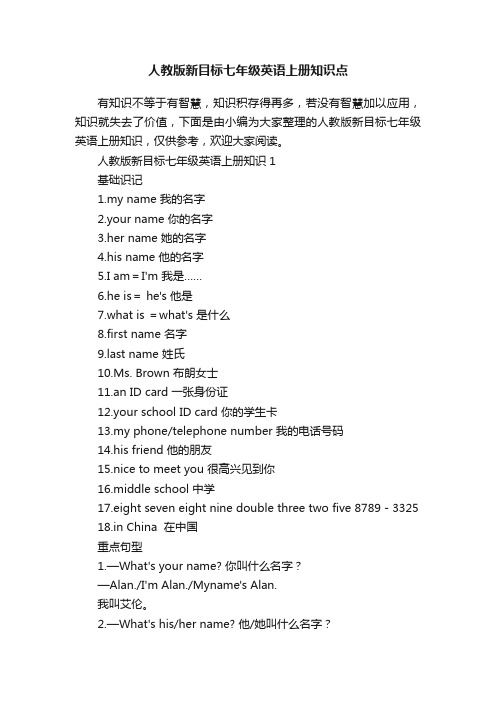
人教版新目标七年级英语上册知识点有知识不等于有智慧,知识积存得再多,若没有智慧加以应用,知识就失去了价值,下面是由小编为大家整理的人教版新目标七年级英语上册知识,仅供参考,欢迎大家阅读。
人教版新目标七年级英语上册知识1基础识记1.my name 我的名字2.your name 你的名字3.her name 她的名字4.his name 他的名字5.I am=I'm 我是……6.he is= he's 他是7.what is =what's 是什么8.first name 名字st name 姓氏10.Ms. Brown 布朗女士11.an ID card 一张身份证12.your school ID card 你的学生卡13.my phone/telephone number 我的电话号码14.his friend 他的朋友15.nice to meet you 很高兴见到你16.middle school 中学17.eight seven eight nine double three two five 8789-332518.in China 在中国重点句型1.—What's your name? 你叫什么名字?—Alan./I'm Alan./Myname's Alan.我叫艾伦。
2.—What's his/her name? 他/她叫什么名字?—He's Eric./His name'sEric./She's Mary./Her name's Mary.他叫埃里克。
/她叫玛丽。
3.—What's your first name? 你的名字是什么?—My first name is Gina. 我的名字是吉娜。
4.—What's your last name? 你姓什么?—My last name is Green. 我姓格林。
人教版新目标英语(Go For It)七年级下册单词完整版笔记

hallway ['hɔːlweɪ] n.走廊;过道
hall [hɔːl]n.大厅;礼堂
dining hall餐厅
listen ['lɪs(ə)n]v.听;倾听
listen to…听…… 【listen to music 听音乐】
fight [faɪt]v. & n.打架;战斗
【fight with sb. 和某人打架 fight the fire 救火】
【an important test 一次重要的考试】 bring [brɪŋ]v.带来;取来 【反义词:take v.带走】 uniform ['juːnɪfɔːm]n.校服;制服 quiet ['kwaɪət]adj.安静的【be quiet 保持安静】 out [aʊt]adv.外出 go out 外出(娱乐) practice ['præktɪs]v. & n.练习【practice doing sth. 练习做某事】 dish [dɪʃ]n.碟;盘 do the dishes清洗餐具
小叶学英语
boat [bəʊt] n.小船 ropeway ['rəʊpweɪ] n.索道 year [jɪə] [ jɜː] n.年;岁 afraid [ə'freɪd] adj.害怕;惧怕【be afraid of sth. 害怕某物】 like [laɪk] prep.像; leave [liːv] v.离开 dream [driːm] n.梦想;睡梦 v.做梦 true [truː] adj.真的;符合事实的 【truth n.真相】 come true实现;成为现实 Dave[deiv] 戴夫(男名)
sorry ['sɒrɪ]adj.抱歉的;难过的;惋惜的
新目标英语七年级上册单词表(全)

新目标英语七年级上册单词表(全)第一单元单词及短语my pron. 我的name n. 名字is v. 是clock n. 时钟I pron. 我am v. 是I'm =I amnice adj. 好的;令人愉快的to part. 用于与动词原形一起构成动词不定式meet v. 遇见;相逢you pron. 你;你们what pron.& adj. 什么what's =what isyour pron. 你的;你们的hello interj.(表示问候)喂hi interj. (表示问候)嗨his pron. 他的and conj. 和;又;而且her pron. 她的question n. 问题;难题;询问;疑问answer n. 问答;答复;答案look v. 看;望;看起来first num. 第一first name 名字last adj. 最后的;上一个的last name 姓氏boy n. 男孩girl n. 女孩zero num. 零one num. 一two num. 二three num. 三four num. 四five num. 五six num. 六seven num. 七eight num. 八nine num. 九telephone n. 电话number n. 数;数字telephone number 电话号码phone n. 电话;电话机phone number 电话号码it pron. 它it's=it iscard n. 卡;卡片ID card (ID=identification) 身份证family n. 家;家庭family name 姓氏第二单元单词及短语this pron.& adj. 这;这个pencil n. 铅笔pen n. 钢笔book n. 书eraser n. 橡皮;铅笔擦;黑板擦ruler n. 尺;直尺case n. 箱;盒;橱pencil case 铅笔盒;文具盒backpack n. 双肩背包pencil sharpener 卷笔刀;铅笔刀dictionary n. 字典;词典that pron.& adj. 那;那个yes adv. (表示肯定)是no adv.(表示否定)不;不是not (构成否定形式)不是adv.isn't =is notthank 感谢v.OK 好;不错interjin 用(表示方法,媒介,工具等)prep.English 英语;英文n.a 一个(只,把,台……)art.how (指程度)多么;何等;怎样adv. do 做;干;构成否定句、疑问句的助动词v.& aux.spell 拼写v.baseball 棒球n.watch 手表n.puter 电脑;电子计算机n.game 运动;游戏n.key 钥匙n.notebook 笔记本n.ring 环(状物);戒指n.call 打电话v.at 在…(里面或附近);在…(点、刻);以prep.the 表示特指的人、物、事或群体art.lost 丢失的;遗失的adj.found (find的过去式,过去分词)找回v.lost and found 失物招领please (祈使句用作请求的客套话)请interjschool 学校n.a set 一套;一副of (属于)…的excuse 原谅;宽恕v.excuse me 请原谅第三单元单词及短语sister 姐;妹n.mother 妈妈;母亲n.father 爸爸;父亲n.parent 父亲或母亲n.brother 兄;弟n.grandmother 祖母;外祖母n. grandfather 祖父;外祖父n.friend 朋友n.grandparent 祖父/母;外祖父/母n. these 这些pron.& adj.are 是v.those 那些pron.& adj.she 她pron.he 他pron.he's =he isson 儿子n.cousin 堂(表)兄弟;堂(表)姐妹n. daughter 女儿n.uncle 叔;伯;舅;姨夫;姑父n. aunt 姨母;姑母;伯母;婶母n. dear (冠于信函中的称谓,以示礼貌)亲爱的adj.thanks for 为……而感谢photo 照片;相片n.here 这里;在这里adv.picture 照片;图片n.for (表示原因或目的)为了prep.第四单元单词及短语where 哪里advtable 桌子n.bed 床n.dresser 梳妆台n.bookcase 书柜;书橱n.sofa 沙发n.chair 椅子n.drawer 抽屉n.plant 植物n.under 在..下面prep.they 他们pron.on 在..上面prep.know 知道;了解v.bag 书包;提包;袋子n.math 数学n.alarm clock 闹钟CD (=pact disc) 光盘abbr. video 录像;视频n.tape 录音带n.video tape录像带hat 帽子n.take 拿走;带到v.thing 东西;物n.to 朝;向;至;达prep.mom (非正式用语)妈妈n.can 能;可以;会modal v.bring 拿来;取来;带来v.some 一些;若干pron.& adj. need 需要v.floor 地板;地面n.room 房间n.TV (=television) 电视;电视机abbr.desk 课桌;书桌n.第五单元单词及短语have 有;吃;饮v.soccer 英式足球n.ball 球n.soccer ball 英式足球tennis 网球n.racket (网球、羽毛球的)球拍n. tennis racket 网球拍ping-pong 乒乓球n.volleyball 排球n.basketball 篮球n.bat (乒乓球等的)球拍n.does (do的第三人称单数)做;干;构成否定句、疑问句的助动词v.& aux.doesn't = dost notlet 允许;让v.us 我们(we的宾格)pron.let's =let usplay 玩;打球v.sound 听起来v.good 良好的;令人满意的adj.sport 运动;游戏n.we 我们pron.many 大量的adj.club 社团;俱乐部n.more 更多的;更大的pron.class (一节)课;班级n. interesting 有趣的;令人感兴趣的adj.boring 无聊的;令人生厌的adj.fun 有趣的;令人愉快的adj.difficult 困难的adj.relaxing 轻松的adj.watch 观看;注视v.watch TV 看电视has (have的第三人称单数形式)有v. great 美妙的;大的adj.collection 收藏品;收集物n.but 但是conj.play sports 参加体育运动或比赛only 只;仅仅adv.them (they的宾格)他(她、它)们pron.every 每一;每个adj.day 天;日间;白天;一日n.第六单元单词及短语like 喜欢v.banana 香蕉n.hamburger 汉堡包n.tomato 西红柿n.broccoli 花椰菜n.French fries 炸马铃薯条;薯条orange 橙子n.ice 冰n.cream 奶油;乳脂n.ice cream 冰淇淋salad 沙拉n.strawberry 草莓n.pear 梨n.have 吃;饮v.oh 啊;噢;呀(表示惊讶等)interj. countable noun 可数名词uncountable noun 不可数名词food 食物n.egg 蛋;鸡蛋n.apple 苹果n.carrot 胡萝卜n.chicken 鸡;鸡肉n.breakfast 早餐n.lunch 午餐n.dinner 晚餐;正餐n.fruit 水果n.vegetable 蔬菜;植物n.runner 奔跑者n.eat 吃v.well 好;对;满意地adv.run 跑;奔跑v.star 星星;明星n.lot 许多;很多adv.lots of 大量;许多healthy 健康的;强健的adj. dessert (饭后的)甜食n.list 清单n.Bill 比尔(男名)Sandra 桑德拉(女名)Clark 克拉克(姓)Review of units 1---6 furniture 家具(总称)n.people 人;人民n.an (元音前)一个(只,把,台…)art. blank 空白n.conversation 交谈;谈话n.other 另外的人(物)pron.also 也;亦;而且adv.Joe 乔(男名)第七单元单词及短语how much (价钱)多少pants (pl.)裤子sock 短袜n.shirt 男衬衣;衬衫n.T-shirt T恤衫n.shorts 短裤n.sweater 毛衣n.shoe 鞋n.skirt 裙子n.sale 出售;廉价销售n.dollar 元(美国、加拿大等国的货币单位,符号为$)color 色;颜色n.black 黑色(的)adj.& n.white 白色(的)adj.& n.red 红色(的)adj.& n.green 绿色(的)adj.& n.blue 蓝色(的)adj.& n.yellow 黄色(的)adj.& n.big 大的;广大的;重大的adj.small 小的;小号的adj.short 短的;矮的adj.long 长的adj.clerk (银行、办公室、商店等)职员;办事员n.help 帮助;援助v.want 需要;想要v.Here you are. 给你wele 不必客气的adj.You’re wele. 不客气。
(完整版)新目标七年级英语上下两册教材分析

新目标七年级上册英语教材分析七年级上册由预备篇(三个单元)和正式篇(十二个单元)两部分组成。
预备篇是为了帮助学生从小学过度到初中专门设置的预备单元,目的是使学生学生能更好地使用这套教材。
在教学中,教师可要根据学生情况及教材内容,对预备篇知识进行适当的、有计划的、系统的补充,尤其是词汇方面的补充。
这就要求我们要了解小学英语和中学英语的知识结构体系以及两者之间的联系和相互渗透的程度。
这样,我们才能把该补充的内容在适当的时候进行补充,才能使这种补充具有科学性和系统性。
二、各个单元教学目标明确学生用书的目录展示了各单元的教学目标,这套教材是在任务型语言教学理念的基础上编写而成的,它的语言教育理念是:强调语言应用,发展学习策略,培养创新精神,突出实践能力。
它以话题为主线,贴近学生的实际生活,要求教师要通过“ 任务型语言教学” 的途径,使学生完成对语言知识的学习、掌握和运用,通过一系列“ 任务” 的设置与完成,把教学过程变成一个学习和运用相融合的过程,快捷地实现语言学习的真正目的。
本套教材兼顾了交际功能和语言知识结构的学习,强调了语言知识在真实情境中的应用。
三、单元结构分析教材采用单元形式编写,每单元有都有Section A, Section B 。
Section A主要介绍和学习本单元的基础语言知识(包括语法),进行核心词汇和核心句型的练习,并设计一些简单的任务,通过任务的完成,达到初步运用基础语言知识的目的;Section B主要加强练习和提高学生在真实情境中运用所学语言知识的能力,并注意培养和发展学生的学习策略。
这一部分主要有三项内容:1 .所设计的任务中出现了接近真实生活的情景,学生在完成任务的过程中需要的语言知识含量逐渐增大,学生更能充分发挥自主能力。
2 .增加了阅读语段和写的练习。
教材要求我们必须要把听、说、读、写四种基本技能通过教学体现在学生对语言知识的运用中去。
实际上,这就是要把这四项技能融合成一种“ 语言意识” ,使学生学会在真实的情境中达到自然使用语言知识的目的。
初中七年级新目标英语上册全册教案新部编本1
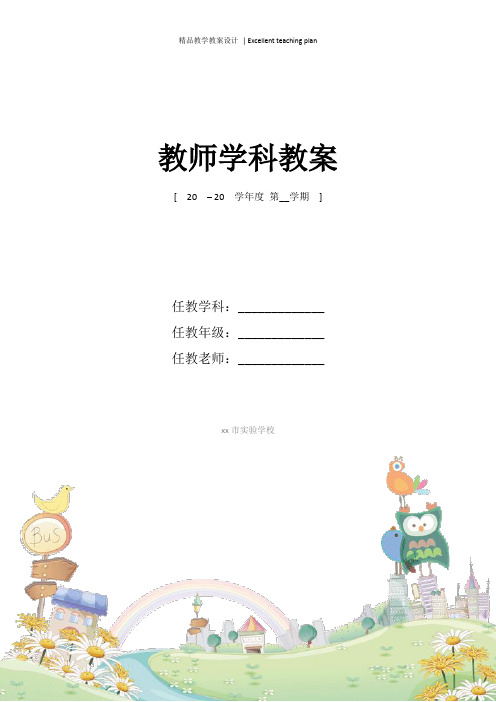
教师学科教案[ 20 – 20 学年度第__学期]任教学科:_____________任教年级:_____________任教老师:_____________xx市实验学校初中七年级新目标英语上册全册教案Unit 1 My name’s Gina第一课时教案示例教学目标1.学会询问周围新同学的姓名,并且将自己刚认识的好朋友介绍给全体同学2.通过学生制作名卡或桌卡来提高学生学习英语的兴趣,体现英语的实用性3.通过以上任务活动,掌握形容词性物主代词的用法及其与人称代词的主格的区别,并且在第一节课让学生对英语的学习产生兴趣。
4.德育目标:热爱班集体,团结同学。
教学重点和难点1.形容词性物主代词的用法2.在任务活动中掌握you和your,he和his, she和her 的用法3.重点句型(斜体字为扩展句子):Hi / Hello! Good morning / afternoon / evening.How are you? Fine, thank you! / Very well / So-so /All right.What’s your name?My name is … / I’m …What’s his/ her name?His/Her name is …课前准备1.学生课前准备:利用网络查阅中英文姓名及初次见面时各国或各地风俗,礼仪体会它们的不同之处;准备硬纸片和水彩笔;用英文介绍自己的姓、名。
2.教学器材:录音机、电脑、图片。
3.教学课件:中英文名字展示片。
教学设计Tasks Students’ activities Teacher’s activities1. Game: ask and answer the question: What’s your name? Students make a self-introduction and pass the sentences one by one. At first, teacher makes a self-introduction.2.Two students act out how to greet people. Act out the greeting forms they are familiar with or they find on net. Show the students the pictures of other countries’ customs with computer.3. See who can make the most friends and get the most information. Then report their results with his or hers. Move around to make friends with the ones they are interested in. Make the students move around to make friends with others.4. Design and make their name cards . Design and make their name cards in groups. Ask them to design their name cards and see which group is the best.教学过程设计任务一:结识新朋友。
七年级新目标英语教学计划(7篇)

七年级新目标英语教学计划(7篇)七年级新目标英语教学计划1一、、本学期的指导思想:1、整体设计目标,体现灵活开放,目标设计以学生技能,语言知识,情感态度,学习策略和文化意识的发展为基础;2、要面向全体学生,关注每个学生的情感,激发他们学习英语的兴趣,帮助他们建立学习的成就感和自信心,培养创新精神;3、突出学生主体,尊重个体差异;4、采用活动途径,倡导体验参与,即采用任务型的教学模式,让学生在老师的指导下通过感知、体验、实践、参与和合作等方式,实现任务的目标,感受成功;二、所教班级学生基本情况分析:本届七年级新生和以往初一学生有着很大的差异,即他们曾在小学学过一,二年英语。
但由于在小学英语课并未受到足够的重视,他们在写的技能方面基本上没有得到过训练,字母还不能规范的书写,更别提什么单词,句子。
在读,说方面,语音也有不少需要纠正的地方,由于各小学授课,英语基础也差参不齐。
三、奋斗目标:钻研新课标,提高自己的教学水平,真正做到教学相长,努力达到学校规定的教学指标。
四、具体措施:1、每天背诵课文中的对话。
目的:要求学生背诵并默写,培养语感。
2、每天记5个生词,2个常用句子或习语。
实施:利用“互测及教师抽查”及时检查,保证效果并坚持下去。
3、认真贯彻晨读制度:规定晨读内容,加强监督,保证晨读效果。
4、坚持日测、周测、月测的形成性评价制度:对英语学习实行量化制度,每日、每周、每月都要给学生检验自己努力成果的机会,让进步的同学体会到成就感,让落后的同学找出差距,感受压力。
由此在班里形成浓厚的学习氛围,培养学生健康向上的人格和竞争意识。
5、对后进生进行专门辅导,布置单独的作业,让他们在小进步,小转变中体味学习的快乐,树立学习的自信,尽快成长起来。
6、关注学生的情感,营造宽松、民主、和谐的教学氛围。
7、加强对学生学习策略的指导,为他们终身学习奠定基础。
8、要充分利用现代教育技术,利用计算机和多媒体教学软件,探索新的教学模式,开发英语教学资源,拓宽学生学习渠道,改进学生学习方式,提高教学效果。
初一英语人教版(新目标)(最新版)上学期期中复习:知识点归纳

初一英语人教版(新目标)(最新版)上学期期中复习:知识点归纳七年级上册期中复习资料一、学习目标1. Starter Units1-3, Units 1-4 单元知识点2. 学会归纳句型,梳理语法知识二、重点、难点重点Starter Units1-3, Units 1-4 的知识点难点高频考点一、单词复习1.3.★Good evening, Bob! 晚上好,鲍勃!★What’s this/ that in English? 这个/那个用英语怎么说?★Spell it, please. 请拼写它。
★What color is it? 它是什么颜色?【高频考点】问候语的答语(1) —Hello/ Hi, Xiao Wang! 你好,小王!—Hello/Hi, Tingting! 你好,婷婷!(2) —Good morning/ afternoon/ evening/ night, Kate. 凯特,早上/下午/晚上好/晚安!—Good morning/ afternoon/ evening/ night, Lucy. 露西,早上/下午/晚上好/晚安!(3) —How do you do? 你好!—How do you do? 你好!(4) —How are you, Jenny? 珍妮,你好!—Fine, thank you. And you? 很好,谢谢。
你呢?—I’m fine, too. Than ks. 我也很好。
谢谢。
Unit 1 My name’s Gina.【重点句型】★—What’s your name? 你叫什么?—My name’s Gina. 我叫吉娜。
★Nice to meet you! 很高兴见到你!★—What’s your first name? 你的名字是什么?—My first name is Tony. 我的名字叫托尼。
★—What’s her last name? 她姓什么?—Her last name is Brown. 她姓Brown。
最新人教版新目标七年级英语上册初一英语上册课文翻译【全册】
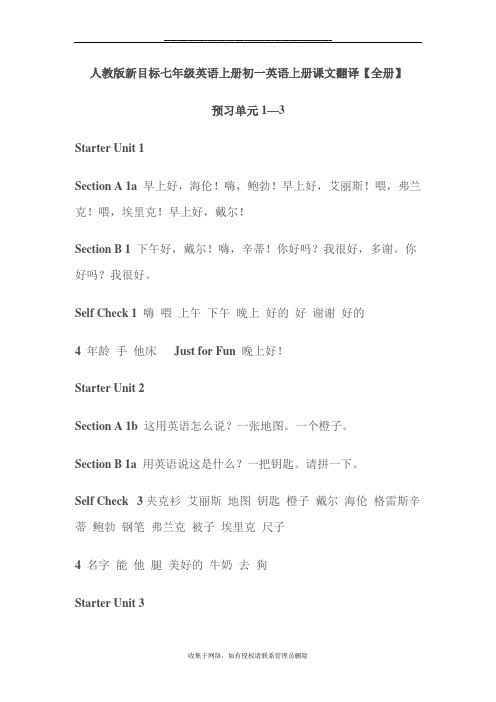
人教版新目标七年级英语上册初一英语上册课文翻译【全册】预习单元1—3Starter Unit 1Section A 1a早上好,海伦!嗨,鲍勃!早上好,艾丽斯!喂,弗兰克!喂,埃里克!早上好,戴尔!Section B 1下午好,戴尔!嗨,辛蒂!你好吗?我很好,多谢。
你好吗?我很好。
Self Check 1嗨喂上午下午晚上好的好谢谢好的4年龄手他床Just for Fun晚上好!Starter Unit 2Section A 1b这用英语怎么说?一张地图。
一个橙子。
Section B 1a用英语说这是什么?一把钥匙。
请拼一下。
Self Check 3夹克衫艾丽斯地图钥匙橙子戴尔海伦格雷斯辛蒂鲍勃钢笔弗兰克被子埃里克尺子4名字能他腿美好的牛奶去狗Starter Unit 3Section A 1a这是什么?它是字母V。
它是什么颜色的?它是红色的。
这是什么?它是字母Z。
它是黑白相间的。
Section B 1b这把钥匙是黄色的。
这把尺子是蓝色的。
这支钢笔是红色的。
Self Check它是绿色的。
字母意思(铅笔芯)硬黑激光唱片英国广播公司停车(美国)全国篮球协会千克小号/中号/大号不明飞行物中央电视台联合国一单元Section A 1a我是吉娜。
见到你真高兴。
Grammer Foucs你的名字是什么?我的名字是詹妮。
我是詹妮。
他的名字是什么?他的名字是托尼。
她的名字是什么?她的名字是吉娜。
Section B 1c你的电话号码是什么,李欣?是281-6926。
3b她的电话号码是什么?她的姓氏是什么?她的名字是什么?Self Check 1我她是身份证什么我的喂你的他的她的名姓电话号码Just for Fun你的名是什么?ZIG。
你的姓是什么?ZAG。
二单元Section A1a那是你的双肩背包吗?不,不是。
它是他的双肩背包。
这是你的铅笔吗?是的,它是。
它是我的铅笔。
这是你的尺子吗?不,不是。
它是她的尺子。
铅笔钢笔书橡皮擦尺子铅笔盒书包卷笔刀词典2b请原谅,索尼亚。
- 1、下载文档前请自行甄别文档内容的完整性,平台不提供额外的编辑、内容补充、找答案等附加服务。
- 2、"仅部分预览"的文档,不可在线预览部分如存在完整性等问题,可反馈申请退款(可完整预览的文档不适用该条件!)。
- 3、如文档侵犯您的权益,请联系客服反馈,我们会尽快为您处理(人工客服工作时间:9:00-18:30)。
新目标英语七年级(上)英语单元检测
题
Unit 1 My name’s Gina.
班级______ 姓名
一.按顺序写出英语26个字母的大小写形式并圈出元音字母(15分)
A: Good morning.
B: _______ _______.
A: I ______ Lucy. What’s _______ _______?
B: My _______ is Jim.
A: Nice to _______ you.
B: _______ _______ _______ _______, _______.
A: How ______ you?
B: I’m _______. _______ . And you?
A: I’m _______, too. _______ you.
B: What’s _______ _______ number?
A: _______ 555-1234.
B: Thank you.
三.用英语写出所缺数字,使等式成立(10分)
1. two + ______ = 9
2. seven + ______ = 15
3. five + ______ = 9
4. three + ______ = 8
5. nine -______ = 8
6. four + ______ = 10
7. eight ÷ ______ = 4 8. six × ______ = 18
9. ______ -eight = 1 10. one × ______ = 0
四.选择填空(20分)
( )1. My name is Lucy Black. My last name is _____.
A. Lucy
B. Black
C. Lucy Black
( )2. Her name is Lily Smith. Her first name is ______.
A. Lily
B. Smith
C. Lily Smith
( )3. His name is John Brown. You can call him _____.
A. Mr. John
B. Mr. Brown
C. Mr. John Brown
( )4. – What’s her name? -- _____ name is Jerry.
A. Her
B. His
C. My
( )5. – What’s his phone number? -- _____ phone number is 555-2341.
A. Her
B. his
C. His
( )6. – How _____ you? -- I’m fine. Thank you.
A. am
B. is
C. are
( )7. I _____ Jim. What’s your name?
A. am
B. is
C. are
( )8. His name _____ Mike Green.
A. am
B. is
C. are
( )9. – What’s your phone number? -- _____ 555-4537.
A. It
B. My phone number
C. It’s
( )10. – How do you do? -- _____
A. I’m fine. Thanks.
B. Hello.
C. How do you do?
五.在方框内选出下面句子的答语,将其字母序号填入句前括号内(10分)
( )2. What’s your first name?
( )3. What’s your last name?
( )4. Nice to meet you.
( )5. What’s his name?
( )6. What’s her phone number?
( )7. What’s her name?
( )8. What’s two and five?
( )9. What’s four and two?
( )10. Good afternoon.
七.
1.p n 2 .r l r 3 .j c et 4 .m p 5. qu l t 6. r n g 7. c l er 8.gr n .9. r d 10.wh t 11. bl ck 1
2. y ll w 1
3. bl e 1
4.pl as
15. n m 16.cl ck. 17. h s 18 h r 19. ques on 20 b y。
